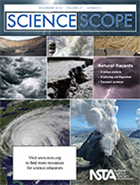Natural hazards
By Mary Bigelow
Posted on 2013-12-26
 We’ve certainly had a variety of weather-related events in recent history: killer tornadoes, devastating hurricanes and floods, and fluctuating temperatures. But the “hazards” that are the focus of this issue are those related to forces that have the potential to shape and reshape the surface of the earth. The content, practices, and crosscutting concepts described in the articles relate to the NGSS performance expectation MS-ESS3-2 Earth and Human Activity.
We’ve certainly had a variety of weather-related events in recent history: killer tornadoes, devastating hurricanes and floods, and fluctuating temperatures. But the “hazards” that are the focus of this issue are those related to forces that have the potential to shape and reshape the surface of the earth. The content, practices, and crosscutting concepts described in the articles relate to the NGSS performance expectation MS-ESS3-2 Earth and Human Activity.
Many teachers have students create erosion models. Authentic Landscapes Indoors: Using Erosion Models to Connect Science and Engineering Practices goes a little further with a 5e lesson in which students observe erosion in their simulations and then design ways to prevent it. The authors provide an activity sheet and suggestions for implementation in the classroom. [SciLinks: Weathering and Erosion]
Sandwich cookies as teaching tools? I have seen lessons with the Moon’s phases depicted in Oreos (Search “oreo” and moon phases for more), but Cookie Tectonics: An Introduction to Earth Hazards and Tectonic Fundamentals introduces a “lithospheric cookie model” to review principles of plate tectonics. The authors provide a summary of important concepts in plate tectonics and a graphic organizer. And then Using Web GIS to Enhance Tectonics Learning and Geospacial Thinking, students can explore the boundaries where events such as earthquakes and volcanic eruptions occur with classroom investigations and GIS tools. Using real data and the data visualizations that are possible help students see the connections between the concepts and real events. [SciLinks: Plate Tectonics, Plate Boundaries]
With the events that happened in Japan still making news, the article Exploring Earthquakes and Tsunamis: Integrating Science, Social Studies, and Technology provides strategies for incorporating technology and reinforcing geographic concepts. The technology includes Google Earth, the Earth 101 app, an online tsunami simulator, and others suggested in the resources section of the article. [SciLinks: Ring of Fire, Tsunamis, Earthquakes]
My hometown is on the east coast of the U.S., and I never thought much about earthquakes happening in my neck of the woods until 2011 when I felt an earthquake centered in Virginia. Your students might be surprised with the real-time data on earthquake events. The author of Bringing Earthquake Engineering to Your Hometown provides a 5e lesson on engineering principles for safe structures in any location, including your own. If students wonder how or even if earthquakes can be predicted, Simulating Earthquake Early Warning Systems in the Classroom has classroom and web-based activities, including a simulation in which students decide on appropriate locations to place sensors. [SciLinks: Seismic Waves, Seismographs]
Disclaimer: The views expressed in this blog post are those of the author(s) and do not necessarily reflect the official position of the National Science Teaching Association (NSTA).


